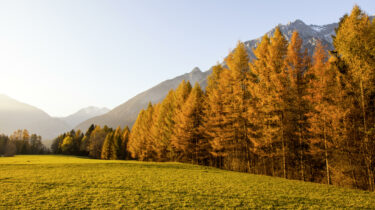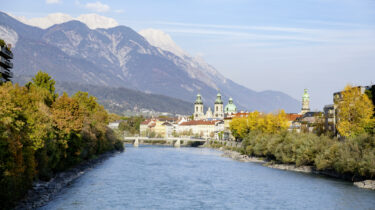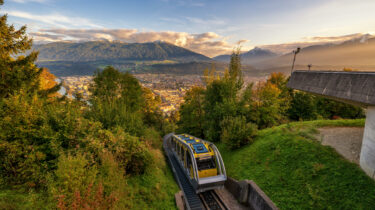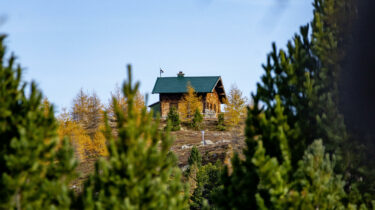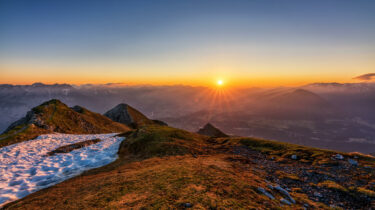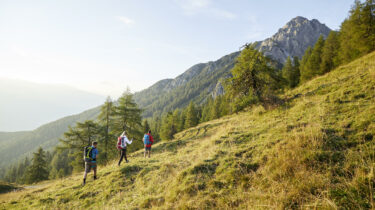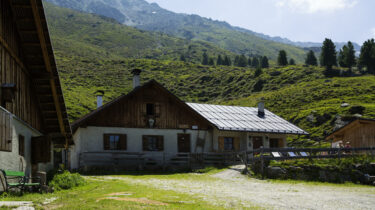Indian Summer in the Innsbruck Region: The five finest Autumn Hikes
Last updated on 25.07.2023
Autumn is hiking season: the temperatures are pleasant, nature appears in all its glowing colours and, on clear days, there are fantastic views into the distance. From leisurely strolls to challenging summit treks, the Innsbruck region offers ideal tours for every hiker. Here we reveal exactly where you can admire the finest natural settings, the most breathtaking views and the most striking colour spectacles.
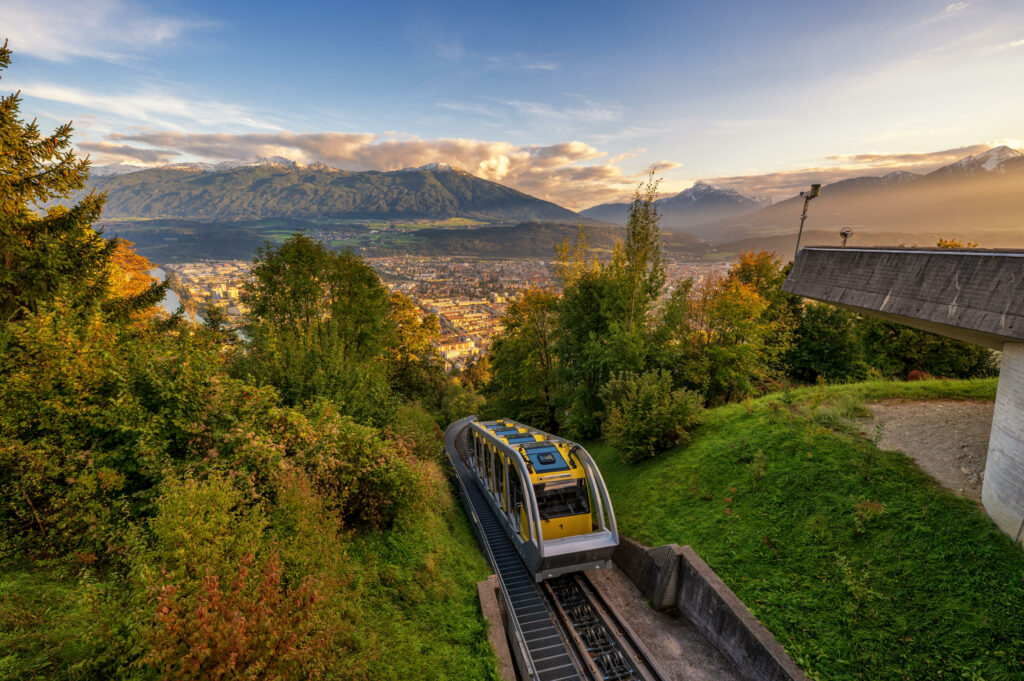
1. A once-in-a-lifetime experience: sunrise on the Nockspitze peak
Early risers will have the summit all to themselves on a sunrise hike up to the Nockspitze. The starting point for this moderately difficult mountain hike is Axamer Lizum, the popular hiking and skiing area not far from Innsbruck. For the ascent we recommend the variant via meadows and forest up to the so-called Halsl. From there the trail continues up a steep, grassy slope and then over rocky terrain to the top. The climb to the 2,404-metre summit – the Saile, as it is also called – takes around two and a half hours. Once up there it is simply a matter of awaiting your reward as, finally, the first rays of the sun peek out from behind the surrounding peaks, gradually bathing the Inn Valley and the city of Innsbruck in their golden autumn light. It is all calm, peaceful and somehow magical: the everyday is now faraway, and there it can stay. As it can be very cool at night and in the early morning in the mountains, be sure to take enough warm clothing with you and pack a head torch so as to be able to see when climbing before daybreak.
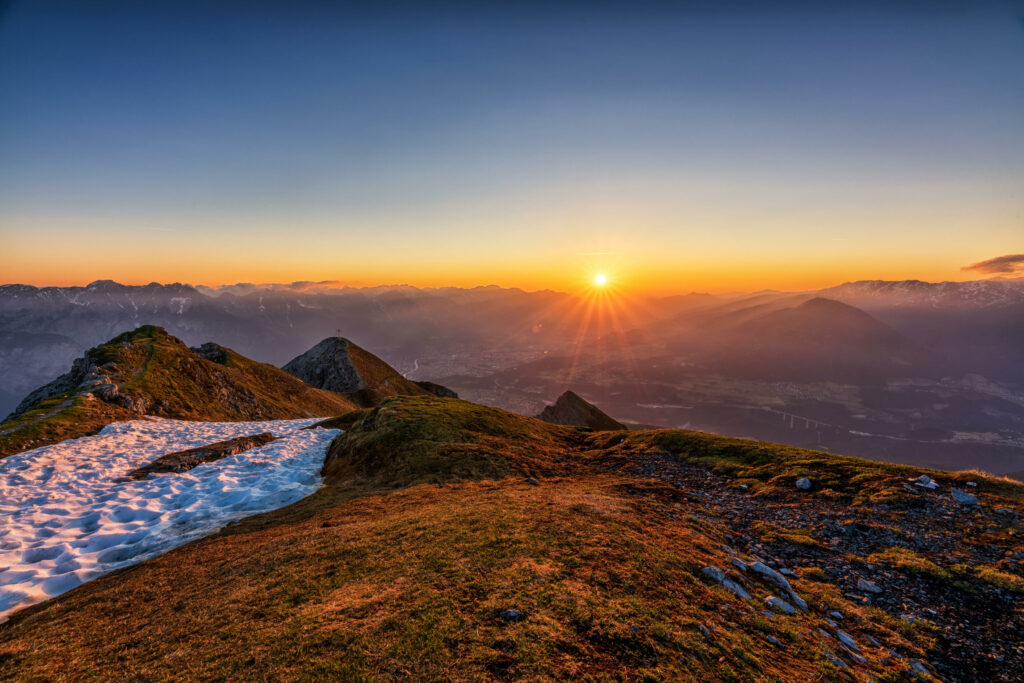
2. Where the “fiery larches” produce beautiful colours
A fascinating natural spectacle can be observed in late autumn each year up on the Mieming Plateau: a colour spectrum that ranges from radiant yellow and orange tones to a warm copper red, putting the spotlight on the otherwise quite innocuous larch trees. This phenomenon is best observed on a short hike along the Obsteiger Larchsteig, the “larch trail”, where various stations also offer all sorts of background information about the trees, their management and the local fauna. Another highlight along the trail are the “foundlings” – boulders that were transported by glaciers to their present location during the Ice Age. In addition to the information points, there are pleasant places to rest, with for example sun loungers where you can appreciate the splendid display of colours in peace and quiet. This short yet delightful circular walk is ideal for families: the route takes some 45 minutes and is almost entirely flat. It starts and finishes at the “Stern”, a country inn in the village of Obsteig where, having admired the larches, hungry visitors can savour regional cuisine with Butz und Stingl, an expression meaning that local fruit and vegetables are used – with practically nothing going to waste.
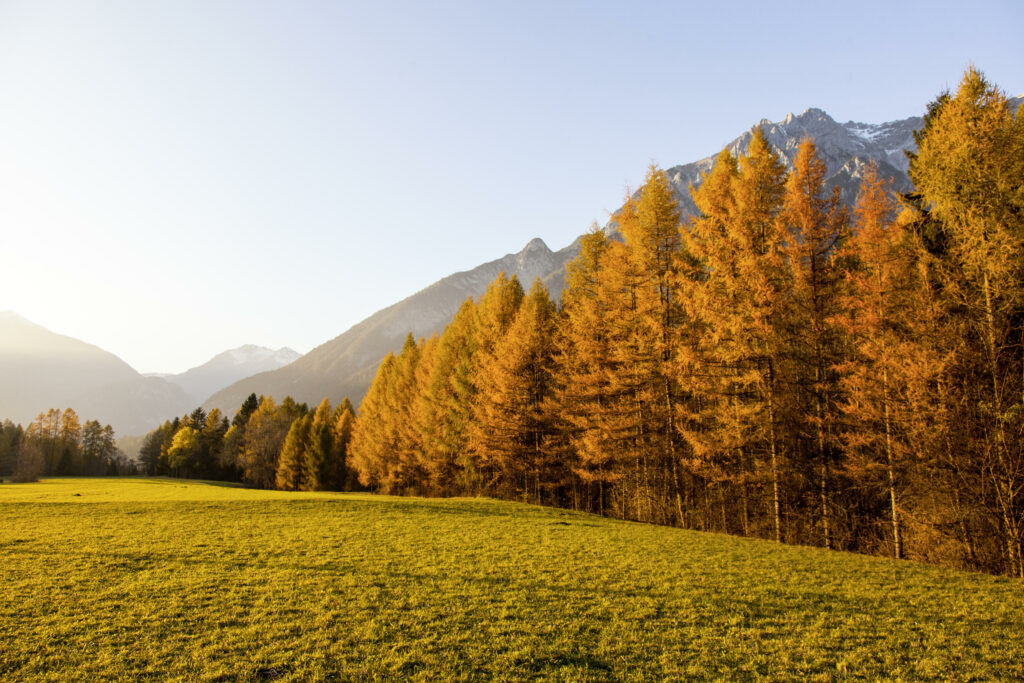
3. A paradise for hikers with the scent of pine: from the Patscherkofel to the Tulfeinalm
This high-altitude hike runs along the Zirbenweg, the Stone Pine Path, past ancient trees and dark red alpenroses at around 2,000 metres above sea level. The Swiss stone pine is known for its soothing and calming effects; it is therefore hardly surprising that the people of Tyrol like to use its wood in their bedrooms and living rooms. The hike starts at the Patscherkofel summit station – a quick and easy cable-car ride up from Innsbruck-Igls – and takes about two and a half hours of leisurely ups and downs to the Tulfeinalm mountain inn. The tour offers numerous magnificent views of the Nordkette range opposite and of the valley of the River Inn. If you want to bag another peak along the way, the Viggarspitze can be climbed in about 30 minutes. For refreshments en route we recommend the rustic Boscheben hut or the Tulfeinalm at your destination, from where you can return to the valley via the Glungezer cable cars. A convenient ticket for circular hikes is available for ascent on the cable cars with the possibility of returning by bus to the Patscherkofel valley station. N.B. the Glungezer cable car is only open at weekends in October.
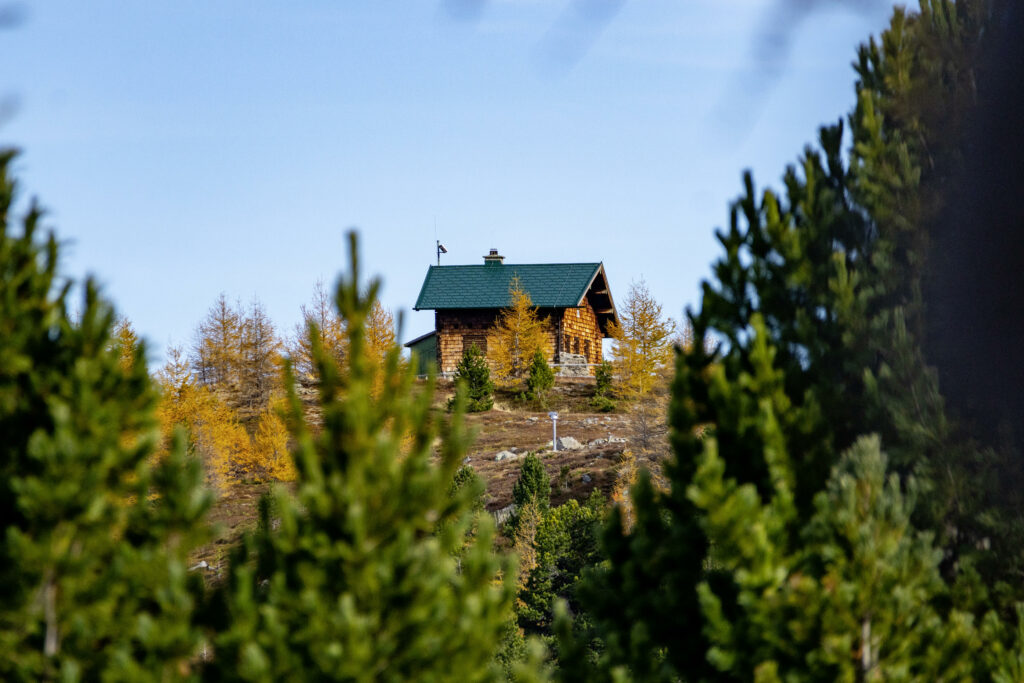
4. The Sellraintal valley: an Eldorado for those seeking peace and quiet
Only about 30 kilometres from Innsbruck is the Sellraintal valley, a place without frills that boasts idyllic side valleys. All is at once quite tranquil here, almost as if the city was several hours away. Here you can enjoy a leisurely climb of some 600 metres along a wide forest path from the Juifenau car park to the Juifenalm mountain inn. The trail at first winds through the bright colours of the forest: should you want a little more exercise in good weather, take the somewhat steeper Sommersteig trail. Once you reach the so-called Jagdhütte (“hunting lodge”), follow the path across the meadows to the inn, located at 2,020 metres above sea level. Here the homemade delicacies – the “grey cheese” and mozzarella – are only surpassed by the fine views of the Sellraintal and Lüsenstal valleys and the surrounding peaks, such as the Rosskogel, Zischgeles and Grieskogel. Note that, in winter, the hiking trail is transformed into a snow-covered toboggan run!
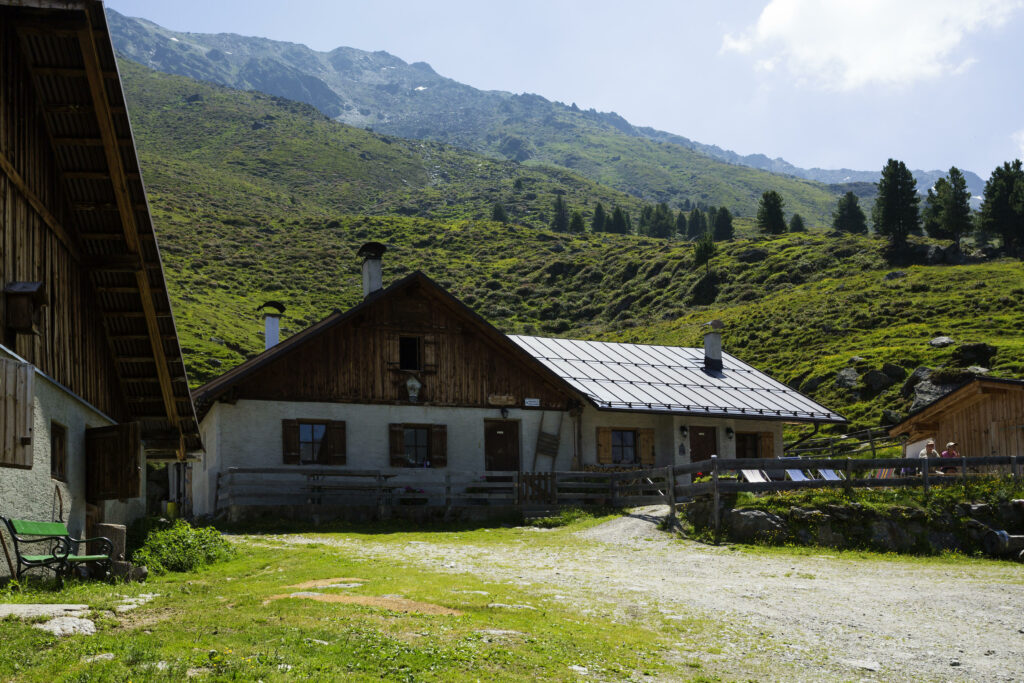
5. Romantic atmosphere along the banks of the Inn – with Alpine fauna and magnificent views
Once the golden autumn season arrives in Innsbruck, we recommend a walk downriver along the Inn promenade, from the Innbrücke bridge to the Hans-Psenner footbridge. The blue shimmering waters of the Inn make an enchanting contrast with the changing colours of the trees. You can turn the walk into a short hike as you cross the wooden bridge, from where it is half an hour on foot to the Alpine Zoo, a must for animal lovers: the enclosures contain over 150 different Alpine animals, including numerous wild species. Afterwards you can walk back or take the Hungerburg funicular. It is also possible to continue along the Wilhelm Greil path to admire the Hungerburg. The views of the changing colours of the leaves, as well as of the city and its surrounding mountains, are all a feast for the eyes; Das Hungerburg restaurant or the Café Alpina can provide hikers with more substantial culinary treats. The return is via the same route or via the Hungerburg funicular, which brings passengers comfortably back to the River Inn. What’s more, the striking silhouettes of the station buildings were designed by top architect Zaha Hadid – a must-see for fans of modern architecture!
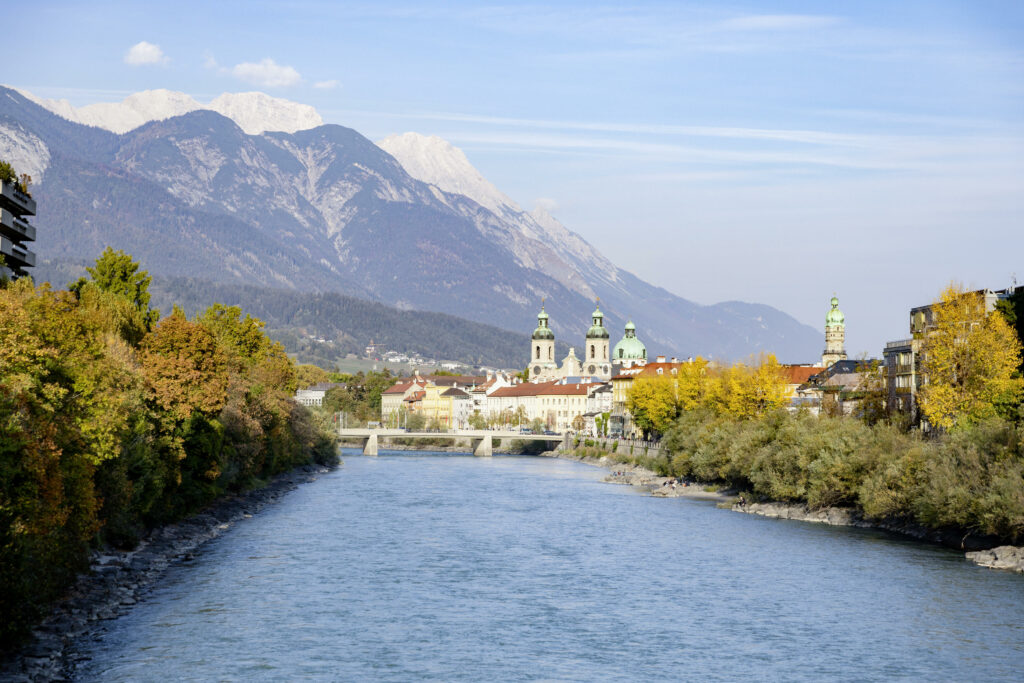
Hiking in safety: hikes need to be well planned and organised to avoid accidents when you are in the mountains: the tourist information offices and the Alpine Club are the right people to contact. Shortly before setting off, make sure you determine the current weather conditions and adapt your equipment and tour plan accordingly. For more demanding tours, book a mountain guide. Stay healthy while in the mountains, as mountain hiking is an endurance sport. The positive effects of stimulating the heart and circulatory system presuppose good health and a realistic assessment of your capabilities. Avoid time pressure and choose a pace that ensures no one gets out of breath. Tip: the free Welcome Card for guests offers participation in guided hikes until 30 October. In addition, the card includes free use of all public transport in the Innsbruck region, allowing you travel in a relaxed and environmentally friendly way to the start of your hiking tour. For all information see www.innsbruck.info/en/destinations/accommodation/welcome-card
About Innsbruck Tourismus
Innsbruck Tourismus is the official destination management organisation for the Innsbruck region, encompassing the capital of Tyrol and over 40 localities in the surrounding area, from the Inntal valley to the Mieming Plateau via Kühtai and as far as the Sellraintal valley. With almost 3.5 million overnight stays (as of 2019), the Innsbruck region is one of Austria’s largest tourism institutions – a unique symbiosis of pulsating urban space and fascinating Alpine world. The vibrant city atmosphere and sightseeing highlights are just a stone’s throw from your next biking or hiking tour, your next ski adventure or winter walk. The Welcome Card, free for visitors, is the key to the region’s boundless opportunities: public transport, usable at no cost, means that the area’s numerous highlights can be enjoyed both sustainably and comfortably. Visitor enjoyment is the focus of the thoughts and actions of each of the organisation’s 90 or so staff: they pass on their passion and enthusiasm for this alpine-urban space to guests, ensuring unforgettable holiday experiences for all in harmony with both people and nature. With a total of twelve tourist information offices, Innsbruck Tourismus can stay close to visitors, be right in the action and keep a finger on the pulse of events – a true hub for the authentic stories and personal impressions of local characters that can be found on the popular blog and social media channels at #myinnsbruck.
Further links
Blog: www.innsbruck.info/blog
Facebook: www.facebook.com/Innsbruck
Instagram: www.instagram.com/innsbrucktourism
Twitter: twitter.com/InnsbruckTVB
YouTube: https://www.youtube.com/user/InnsbruckTVB
Pinterest: www.pinterest.at/innsbrucktvb/_created

